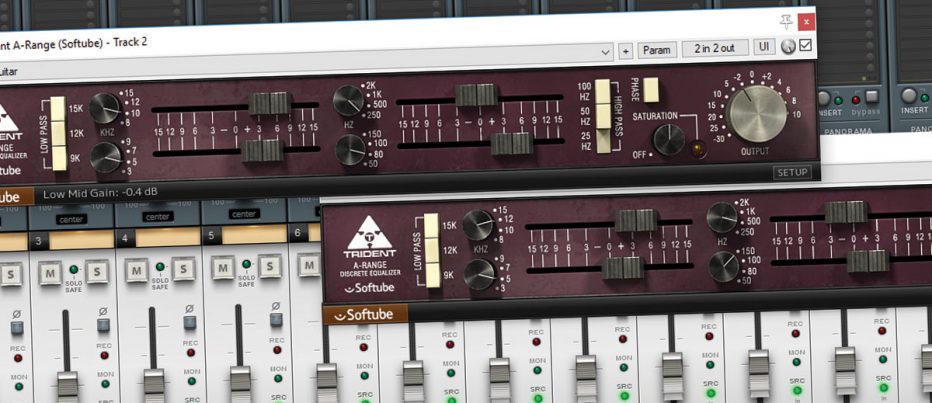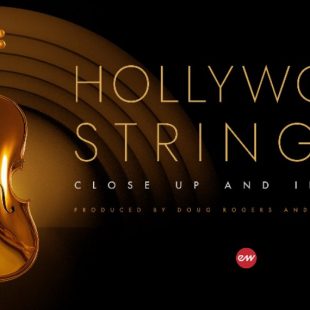Softube Trident A-Range EQ – A Rare Breed
Swedish developers Softube is well known for collaborations with Native Instruments, Universal Audio and Marshall, plus of course, their own detailed emulations of classic outboard studio equipment. This week we’re looking at their Trident A-Range EQ plugin, modelled from one of the rarest of all console channel strips. Could this be the holy grail plugin?
The Trident A-Range EQ plugin has been available for nearly 10 years now, so it’s about time we had a good play with it to see if it both holds up to the current competition and of course, if it sounds any good. There are a number of emulated vintage console plugins out there, so plenty to choose from when you’re looking for more mojo in your mixes.
(Review updated March 2021) Since very few people have laid their hands on the original Trident A-Range console, the reputation for this EQ comes largely from myth and hype. Of course, plenty of rock stars used these consoles to record back in the day, but then again they use thousands of consoles, with different engineers and studios. Pinning all the kudos of the EQ strip from such an obscure desk seems a bit of a stretch for me, however, it comes with the designer’s full praise and approval, including a written testimonial in the owners manual, so I’m guessing we’re at least dealing with something quite authentic here.
Excited to get into this one, let’s check it out.
Overview
The original Trident A-Range mixing console was designed by now legendary engineer Malcolm Toft, he specifically built it for use at Trident Studios where he was working, and only 13 were ever made. Though they were largely overlooked by the Neve and SSL alternatives, a lot of historically important recordings were made on them.
Even though Trident is a world leader in mixing console, rack hardware and even studio monitor speaker design today, this software variant is from the original ’15’ channel from Sweet Silence Studios in Denmark. At $199 USD, this is a good chunk of change and not something your home studio guy will be thrilled about, however, the alternative clocking in at nearly $5000 USD, the hardware rack variant is only for those with a high-end budget.
Road Test
I have approached this review from a layman’s standpoint since, of course, I have zero experience with a real Trident mixing console. Testing an EQ is also very subjective, so many factors play a role in the outcome of your mix. Usually, one of the big factors is the source material itself, especially when testing vintage emulators with saturation effects.
As far as VST EQ effects go, the Trident A-Range would have to be the most simplistic you can get. Other than the slightly wacky sideways faders, the frequency bands are notched, as are the filter passes – so it’s basically a matter of choosing something and turning it up. Interestingly, I found fairly consistent results with all sound sources with the Trident A-Range, well-rounded with no harshness, no matter how hard you hit the incoming signal. Though you get 15db of fader sweep, it’s way softer than a digital plugin, so feels like less.
The most effective use is as track colour, you’re not going to use this for corrective work. The subtle feel actually gives you more confidence to push harder, especially with the saturation, which only kicks in with more aggressive frequency band input.
I adore the 10k filter, it was my favourite notch on my old Triton console, and my first go-to when testing plugins for that wide-open, airy sound – any hint of fizz or digital crap and I’m not interested. Fortunately, Softube has done a fantastic job on all the bands, 10k included. 8k is another nice one for boosting hi-fi clarity on track mixes, again sounding great.
The mid-high and mid-low bands are unusual and slightly tricky to work with. Since they are permanent bell-shaped, the response curves overlap each other in unpredictive ways, you get a lot of crossfade into neighbouring bands. It’s a characteristic of the design but gets you by surprise at first, especially if you’re attuned to digitally perfect modern EQs.
The low-mids are missing my favourite 400k, but 500 is close enough and works perfectly well for de-boxing drums and pretty much anything you throw at it. I have to be honest, the low cut is not enough for me, mostly because I generally like to roll off 100k and boost 100k with a high-Q band – you can’t get that kind of precision with the A-Range. According to the manual, the pass filters cut off around 12db, but you can tilt the frequency point by selecting all three buttons ‘in’ mode, and by my analyzer, it looks to drop another 2-3db on average. The slope is still very soft, so don’t expect brick wall cuts here, it’s a gentle roll-off.
Interestingly, even negative filtering sound good. By this I mean, you can accentuate the boost on a curve by reducing the opposite equally. This might sound logical – but try that on any digital EQ and you’ll just get thin and tinny. This ‘sea-saw’ juggling approach works well and is something I haven’t seen done successfully in a VST plugin.
What the end result of all this testing really comes down to is you should just trust your ears. Approaching A-Range with an analytic mindset won’t work because of the organic nature and how the bands interact with each other. It can be a little frustrating if like me you tend to pinpoint traditional frequency bands to ‘fix’ overtones. Annoyingly, you can achieve plenty of mojo by just blindly fumbling through and moving stuff around, everything just sounds better.

Too much of a good thing can certainly affect your judgment, and I found mixing still rather tricky. I tested on a large 60-track rock mix, and though I was getting excellent individual track results, and the full mix sounded fat, warm and all those other analogies we love to throw around, when I stepped away from the mix to relax my ears for a few hours, I came back and felt everything was overhyped.
The Trident A-Range, in my opinion, responds better to high dynamic range sources, so inserting a pre-EQ compressor that can hit the signal pretty hard first works best. You can also use the EQ to somewhat compress a frequency range, by pushing bands hard and introducing a lot of saturation, which widens and compresses the sound dramatically. In this way, you can pull back and spread out broad problematic areas of a track.
This is a very characterful filter, to use it for any other reason than to add colour will not work. I am particularly happy with the saturation effect which is super-subtle. The word ‘gimmick’ did come to mind when I first saw it, but happily it adds only the slightest hint of channel distortion, with more noticeable effects as you increase the filter boost – as it should be.
Even on a high track count mix, Trident A-Range had very low DSP demands, topping around 1.5% per instance on our test machine. There are only two very minor UI quirks, the non-scalable interface looks tiny on our high rez monitor, and you can’t reset values by not-clicking. Nothing deal-breaking, of course, it just feels like it could benefit from a 2017 update.
Conclusion
At $ 199 USD this is serious money for a single EQ, and though there has been a lot of effort put into the design to capture the original nuances of channel 15, it’s defiantly a luxury purchase for project studios. I suggest you try the free 20-day trial first, but if you’re looking for a character EQ like this you’ll probably not want to give it back.
It’s a very unusual EQ to use, mostly in that you don’t really need to worry too much about pinpointing frequency bands or sweeping for overtones. Pretty much decide what you need more of, then boost it, everything will just sound better. It’s kind of counter-intuitive if you’re a by-the-numbers type engineer like me. Don’t get me wrong, this is not a magic pill or ezy-mix for dummies, you still need a good degree of skill and taste to balance your mix out, it is just the first EQ I’ve used since my old analogue days where you instinctively follow your ears, not your eyes. It’s utterly brilliant, actually.
It’s a different vibe to your Pultec or 1073 but in the same vein. It’s way too broad for anything corrective but ideal for adding colour. If there’s something in your mix that is too upfront or aggressive, the A-Range is perfect for settling it back in.
The Trident A-Range is the EQ you bring in to sweeten the mix, add your mojo or whatever term you like to use. There are a lot of plugins on the market that will promise this, but few offer such a simple workflow and authentic testimonial from the original builder – and for once I’m willing to believe something I’ve read on the Internet.
Full details and a free 20-Day trial are available on Softubes main website www.softube.com
Like the review? Shout us a cup of coffee!






